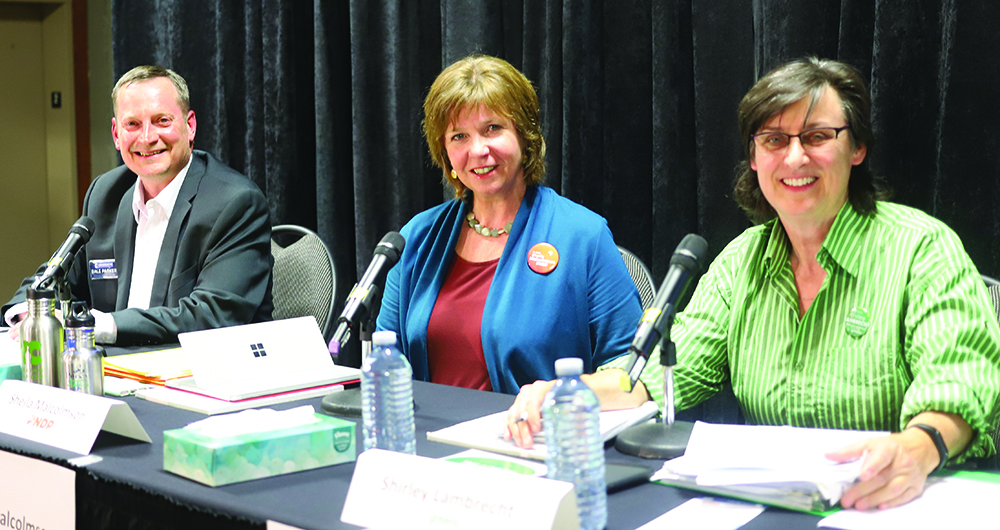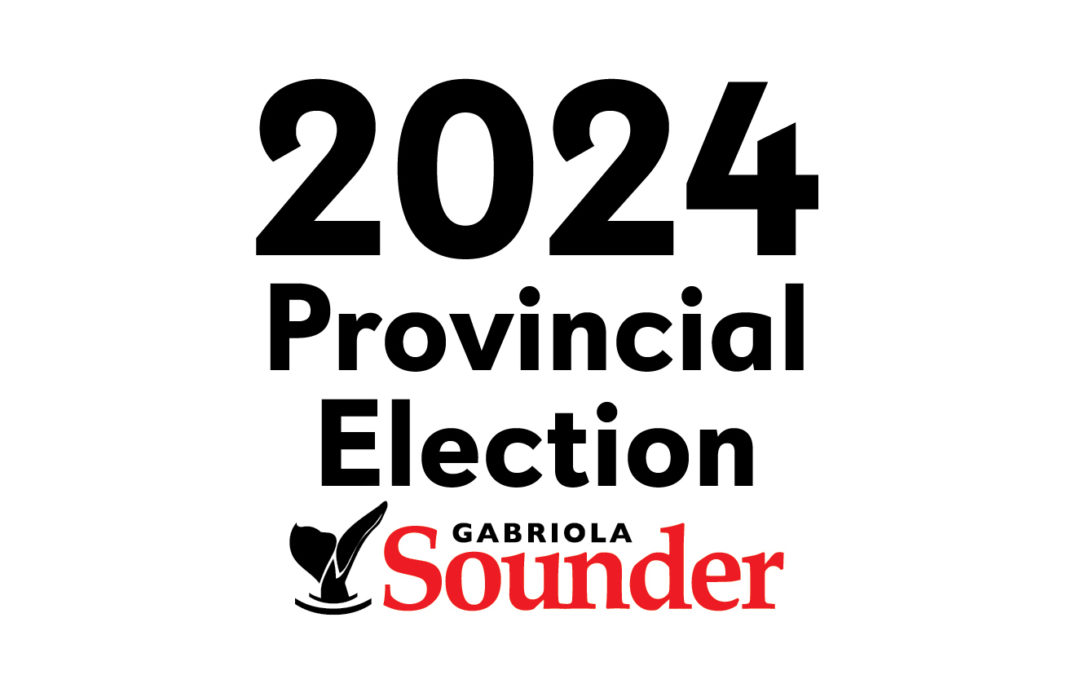
The candidates running for Nanaimo-Gabriola in the 2024 Provincial Election. L-R: Dale Parker (Conservative Party of BC); Sheila Malcolmson (BC NDP); Shirley Lambrecht (BC Greens). Sounder photo
Derek Kilbourn
Sounder News
There is still come question as to who will form the next provincial government in BC, as preliminary results from the 2024 Election on Saturday, October 19 were too close to call.
As of Sunday, October 20, the BC NDP were leading or had elected MLAs in 46 districts. The BC Conservatives were leading or had elected MLAs in 45 districts. The BC Greens were leading in two districts.
A party needs 47 districts to form a majority government.
In Nanaimo-Gabriola, it looks clear that incumbent Sheila Malcolmson of the BC NDP will be the MLA, as she took in 14,084 votes, compared to Dale Parker (Conservative Party) who took in 9,386 votes, and Shirley Lambrecht of the BC Greens, who took in 3,380.
The BC NDP will also have MLAs from Nanaimo-Lantzville and Ladysmith-Oceanside, as George Anderson and Stephanie Higginson won in those districts.
Leaders David Eby (BC NDP) and John Rustad (Conservatives) both won their respective seats, however Green Party Leader Sonia Furstenau lost in her district to BC NDP candidate Grace Lore.
Statement from Premier David Eby
Premier David Eby issued the following statement saying, “I want to thank everyone who cast a ballot in this important election about the future of our province. Our democratic institutions remain strong and British Columbians can have faith that every vote will be counted. While the count will be finalized in the days ahead, our BC NDP team won the most votes and we hold the most seats. However, we did not secure a majority government.
“To British Columbians who voted for change, I hear you and the serious message you have sent. We have not done enough and we must do better.
“Working to fix the tough challenges people are facing is what drives me — it’s what gets me out of bed in the morning. I’m committed to working with the legislature you elected to deliver for you.
“While elections are oppositional in nature, as British Columbians we are far more united. We all care about lowering the cost of living, building homes people can afford, making sure health care is there when you need it, and ensuring we live in safe communities in a clean environment with a strong economy.
“After a close and hard fought campaign, you, British Columbians have asked us to come together and work to make life better. I am determined to listen and get down to work for you. That’s what we were elected to do.”
Initial count
According to ElectionsBC, initial count began after polls closed at 8 p.m. Pacific time on October 19. Results from voting places with tabulators were reported faster than ever before, with first results reported within 15 minutes and over 50% of results within 30 minutes. There were non-technology voting places throughout the province, and results from these manual counts were not reported until later in the evening. Extensive out-of-district results from B.C.’s “vote anywhere” model also took more time to report.
Elections BC’s goal was to report 50% of preliminary results by 8:30 p.m., which was achieved with 59% of preliminary results reported by that time. By 9 p.m. 85% of preliminary results had been reported. Under the manual counting processes in the 2017 B.C. election, 13.5% of preliminary results had been reported by 9 p.m. on election night.
Results reporting on election night slowed after 9 p.m. for several reasons. The manual count of ballots at non-technology voting places took longer to complete and report. For voting places with tabulators, election officials were focused on reporting out-of-district ballots. Out-of-district ballots take longer to report because election officials must report ballots from multiple electoral districts (in some voting places ballots from over 50 other districts had been cast). On Elections BC’s website, many districts showed their results complete except for one ballot box from Final Voting Day. Before confirming that all ballot boxes from advance voting and final voting have reported, election officials check that the results they have reported are accurate as a quality assurance measure. This process took time but was essential to ensure results had been reported accurately.
Results reporting paused early in the morning on October 20 with results 99.72% reported, and resumed later on the morning of October 20.
Most types of ballots are counted at initial count. This includes ballots from advance voting, Final Voting Day, and mail-in ballots received by mail before the close of advance voting. Some ballots cannot be counted until final count, because they require additional integrity checks to ensure the voter was eligible to vote and that they only voted once. Ballots counted at final count include mail-in ballots returned after the close of advance voting, and out-of-district ballots cast by voters at non-technology voting places.
Final count
Election officials are now preparing for final count, scheduled for October 26 to 28. As part of this process, further quality assurance checks are conducted on the results reported at initial count. Any transcription errors identified will be corrected on the Elections BC website and candidates will be notified. Ballots considered at final count are screened before being counted to ensure that the voter was eligible and that they only voted once.
Final count includes absentee and mail-in ballots that cannot be counted at initial count. The majority of the ballots counted at final count will be mail-in ballots. Packages could be returned up until 8 p.m. Pacific time on October 19, either by mail or in person. Many packages were received close to the deadline and must be counted at final count. Elections BC estimates that approximately 49,000 ballots will be considered at part of final count. A breakdown of the number of ballots being considered at final count by electoral district will be provided before final count starts.
Voting results will be updated on Elections BC’s website during preparations for final count the week of October 21 (to correct any transcription errors) and while final count progresses from October 26 to 28.
Recounts
District electoral officer recounts will take place in the Juan de Fuca-Malahat and Surrey City Centre electoral districts. Under the Election Act, recounts must take place in these districts because the difference between the top two candidates is 100 votes or fewer. These recounts will take place as part of final count between October 26 and 28. Under the Election Act, ballots at district electoral officer recounts are counted manually, by hand. Candidates or official agents can also request district electoral officer recounts until October 22. Recount requests may only be made for the reasons outlined in section 139(2) of the Election Act.
Judicial recounts may occur after the conclusion of final count. If the difference between the top two candidates in an electoral district is less than 1/500th of the total ballots considered, a judicial recount must take place. Judicial recounts are conducted by a justice of the Supreme Court of British Columbia and may include some or all of the ballots in an election. Judicial recounts can also be requested by a candidate for the same reasons as a district electoral officer recount (see section 139(2) of the Election Act). Judicial recount requests must be made within six days of the conclusion of final count (November 4).
Voter turnout
At the conclusion of initial count, voter turnout was estimated to be 57.41%. This is up from the last B.C. election in 2020, in which 53.86% of registered voters cast a ballot. As of the close of initial count, 2,037,897 ballots have been cast, the most ever in a provincial election in B.C. The previous record was 1,986,374 votes cast in the 2017 provincial election.





Recent Comments